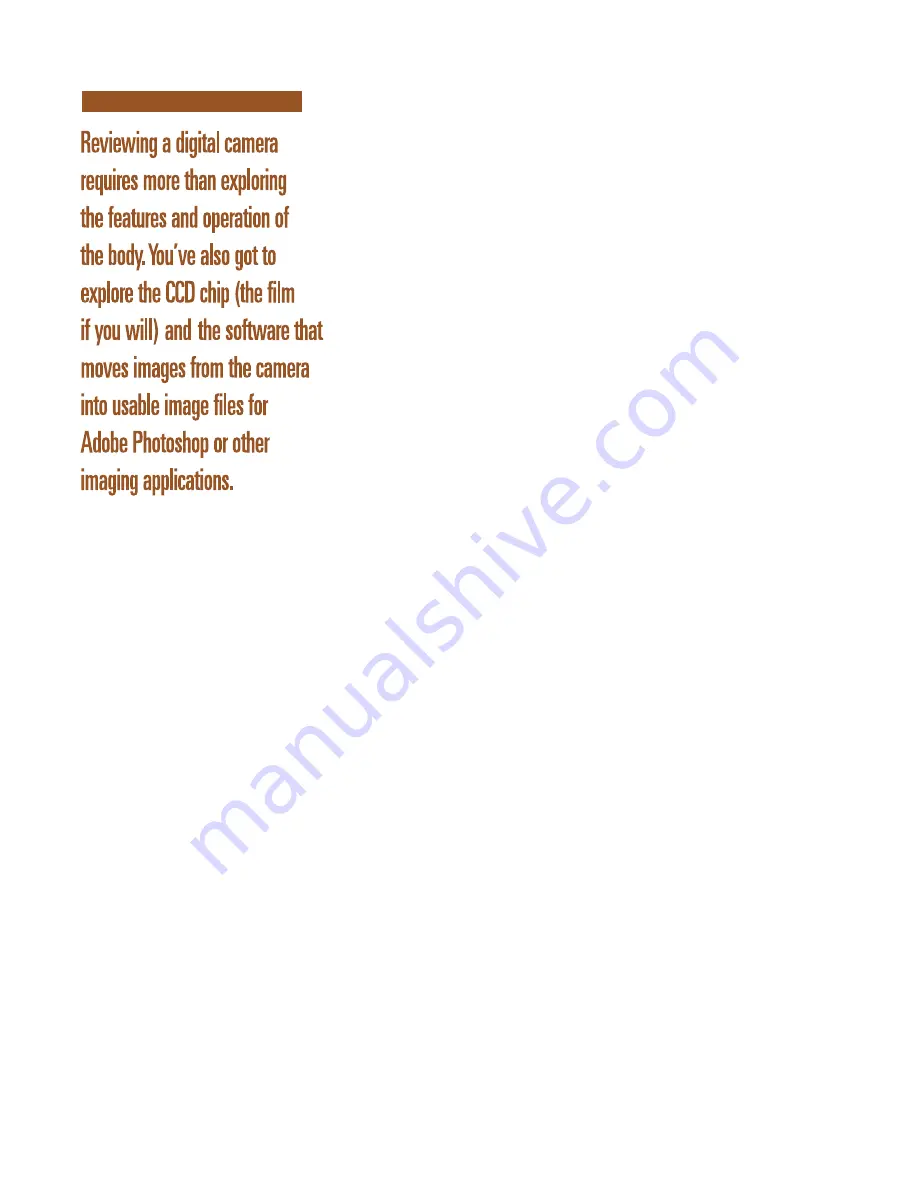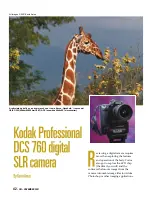
bad. I used version 1.1.12. Kodak
has some work to do to bring this
application up to the level of the
camera it is designed to support.
Acontact sheet appears on the
screen when a folder of Kodak DCR
files is opened in Photo Desk. Double-
clicking an image renders it in a
few seconds to a larger version that
can be viewed at 25, 50, 100, or 200
percent. This is helpful for checking
details. Moving around in an image
larger than the screen can only be
done with scroll bars or arrows.
Kodak needs to add a hand tool
like the one in Adobe Photoshop that
allows navigation by holding down
the space bar and dragging the result-
ing hand icon. Keyboard zoom
shortcuts would be helpful as well.
Holding down the command
key and clicking additional images
makes multiple selections. This is
contrary to the Mac OS standard,
the shift key. These can be seen in a
larger view by choosing the review
feature in the view menu. It is
quicker to use though not as high
quality as the rendered method.
Selected thumbnails can be rotated
and have their color temperature
changed in Photo Desk. Aslider con-
trols exposure compensation of plus
or minus two stops in fifth-stop
increments. There is no option for
curves or levels adjustment, nor is
a histogram available as it is in
Kodak’s software for the Pro Back.
Kodak names the DCS series cameras
“Professional,” and they are. Why
not include professional workflow
solutions in the software that
manages the images? Companies
like Leaf and Foveon have mastered
workflow in their software.
Selected images can be renamed
and saved either as a native DCR
file or as a JPEG or TIFF file in either
8 or 16 bits. The DCS 760 names
captured images in an arbitrary
manner that ensures that no two
files will ever be named the same
and possibly overwritten during a
shoot. To catalog photographs with
a job name or number, the file must
be resaved in Photo Desk. This is
not a problem except when you
need to rename and save a large
number of files. This software
works well with folders of no more
than 200 images and so as long as
the application’s memory has been
increased to 300MB or more. Photo
Desk crashes when asked to open a
large number of files due to its
need to open each file in memory.
This is not a problem for most
photographic projects. After my
safari, however, with almost 4,000
images using 30GB of storage, a
batch processor for rotating,
renaming, and making JPEG files
for copyright registration would
have been a huge timesaver.
Kodak Professional DCS Camera
Manager software (included) is
better than Photo Desk because its
purpose is simpler. As its name
implies, its job is to manage the
camera or cameras (up to 63 of
them at once if the computer’s
resources can handle that many).
Almost all of the settings that
can be changed at the camera can
be made with Camera Manager
running on a tethered computer.
The camera can be fired and files
renamed and saved through a
Firewire connection. It can also be
triggered from the camera itself.
Files can be saved on a card and/or
transferred directly into the
computer’s hard drive through a
Firewire cable of up to 75 feet using
repeaters. This software is a great
help in the studio. Clients love to
see images on a big monitor. Since
Camera Manager also dynamically
updates the Photo Desk contact
sheet, clients can see their images
appear as they are taken.
Bottom Line
The really great news is the
Kodak Professional DCS 760 is a
superior digital camera that holds its
own with imagers in the medium-
format range. It is solid, well
thought out and executed. It goes
on location and functions without
need for technical support right out
of the box. On safari in Africa and
about as far as one can get from help,
it preformed flawlessly under adverse
conditions from before dawn to
after dusk. I highly recommend the
Kodak DCS 760 camera to anyone
serious about digital capture.
Kevin Ames is a digital commercial pho-
tographer in Atlanta. He is an
international lecturer on digital capture,
Adobe Photoshop, and the digital
workflow. His work has appeared in
Time, The Wall Street Journal, PEI,
and
Professional Photographer
. He is
chairman of the Professional Photog-
raphers of America Commercial/
Advertising Group and co-chairman of
PPA’s Digital and Advanced Imaging
Technology Committee. See more of
Ames’ work at
www.amesphoto.com
,
and e-mail him at
kevin@amesphoto.com.
46
• PEI • NOVEMBER 2001





















